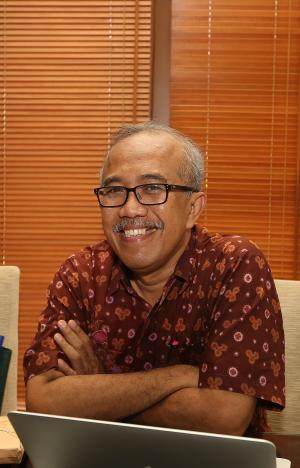Scientific Oration of Professor Chair Holder of IPB: Reproductive Biotechnology to Prevent Wildlife Extinction

The populations of Indonesian endemic animals continue to experience the loss of their natural habitat. Many of Indonesia's most iconic and well known species are also mostly endangered, is the Sumatran rhinos that live at low densities and are mostly solitary. The other endangered species native from Sumatra is orangutan which has low reproductive rates. As the forests are cleared and access to the deepest regions of the park becomes easier, the other serious threat to rhinos increases: poaching. If allowed to develop naturally, the estimated population of Sumatran rhinos in Indonesia will be headed for extinction. Habitat protection, protected area management, community development, policy advocacy and awareness raising must be implemented to conserve their habitats.
This statement was stated by Professor Chair Holder of the Faculty of Veterinary Medicine, Bogor Agricultural University (FKH-IPB), Prof. Bambang Purwantara, during press conference pre his scientific oration, at Campus IPB Baranangsiang, Bogor, on Thursday, 25 August 2016. During which he described some reproductive technologies to improve livestock production and prevent the wildlife extinction.
According to him, the role of reproductive technologies are critical in promoting productivity increase of livestock in Indonesia. There are three reproductive technology in animal production, namely the artificial insemination (first generation), embryo transfer (second generation) and in vitro embryo production and manipulation variants (third generation).
First, the Artificial Insemination (AI). It is the process of collecting sperm cells from a male animal and manually depositing them into the reproductive tract of a female. In addition, natural breeding is physically stressful. Both of these factors limit the number of natural matings a male can make. However, collected semen can be diluted and extended to create hundreds of doses from a single ejaculate. Also, semen can be easily transported, allowing multiple females in different geographical locations to be inseminated simultaneously, and semen can be stored for long periods of time, meaning that males can produce offspring long after their natural reproductive lives end. Presence technology allows the preservation of semen can be stored in liquid or frozen form that allows it to be transported to various regions of the world. In cooperation with two Balai Inseminasi Buatan (BIB – Artificial Insemination Agencies) in Indonesia and the cooperative dairy cow begins to have common data recording system, this study could be a solution devastating for selecting candidates superior male in BIB and Central Artificial Insemination Regions (BIBD).
Second, Embryo Transfer. Embryo transfer operations are expensive so it is only suitable for Prime Livestock Breeding. Embryo transfer towards a female cow which has been superovulated and then inseminated with an excellent male sperm could produce up to 40 excellent and identical calves every year, compared to natural mating or AI, which could only produce 1 calf per year. Even identical twins could be made in large amounts by using the “Cloning” technique. ET technology could also determine the calves’ sexes (male or female) as desired. For Indonesia, to be successful in implementing the ET, steps must be taken. First, improving the embryo quality of donor to obtain maximum fertility. As well as the improvement of recipient thus pregnancy rate per transfer is better. Third climate conducive environment for breeding industry in order to get the best price of offsprings according to the grades. Fourth, develop hormones and biological materials businesses as if they have to be imported cause high costs.
Third, is embryo production. Embryo production, both in vivo and in vitro, is a reproductive technology generally used to improve the number of offspring from selected females. This technology involves three major steps, oocyte maturation, fertilization and embryo culture up to the blastocyst stage, which require different culture media and incubation conditions.
On this occasion, Prof. Bambang explained about stem cells as ii is a new hope. Stem cells are undifferentiated biological cells that can differentiate into specialized cells and can divide (through mitosis) to produce more stem cells. The adult stem cell can renew itself and can differentiate to yield some or all of the major specialized cell types of the tissue or organ. Spermatogonial stem cells (SSCs) are at the foundation of spermatogenesis and male fertility, whereas the oogonial stem cells (OSCs), has opened new avenues for treatment of female infertility. SSCs are the only adult stem cells that are capable of self renewal and that differentiate to produce haploid cells transmitting genes to next generation. SSC will maximize the production of cement for AI, and also important instrument to introduce genes in the population. (Wied)



